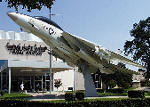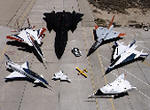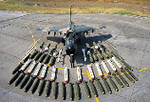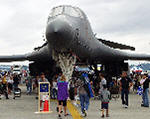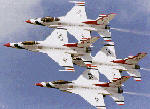
|
Description
| Manufacturer: | Northrop | |
| Base model: | X-21 | |
| Designation: | X-21 | |
| Version: | A | |
| Designation System: | U.S. Air Force | |
| Designation Period: | 1948-Present | |
| Basic role: | Research | |
| Crew: | 5 | |
| First Flew: | 1963/04/18 | |
Specifications
| Length: | 75' 2.5" | 22.9 m | |
| Height: | 25' 6" | 7.7 m | |
| Wingspan: | 93' 6" | 28.5 m | |
| Wingarea: | 1,250.0 sq ft | 116.1 sq m | |
| Empty Weight: | 45,828 lb | 20,783 kg | |
| Gross Weight: | 83,000 lb | 37,641 kg | |
Propulsion
| No. of Engines: | 2 | ||
| Powerplant: | General Electric J79-GE-13 | ||
| Thrust (each): | 9,400 lb | 4,263 kg | |
Performance
| Range: | 4,780 miles | 7,697 km | |
| Max Speed: | 560 mph | 901 km/h | 487 kt |
| Ceiling: | 42,500 ft | 12,953 m | |
Examples of this type may be found at
| Museum | City | State |
| Air Force Flight Test Center Museum | Edwards AFB | California |
X-21A on display
Air Force Flight Test Center Museum |
Recent comments by our visitors
| (James) Baxter Clifford Miami, FL | I was working at the Norair windtunnel when the B-66's came in. The first was delivered without incident; however, the second landed further down the runway, a little faster, and the parachute brake failed to deploy. The pilot retracted the landing gear, and the plane skidded to a stop part way across the street at the west end of the runway.
The concept started when Northop was developing the B-35 and B-49; and a celebrated Swiss expert on boundary layers, Werner Pfenninger (sp?) was hired to pursure the concept. The aircraft, according to reports, worked well, but the maintenance needs of a BLC aircraft doomed the concept. 08/25/2014 @ 10:26 [ref: 68623] |
| Richard Reilly St, MN | I never worked directly on the X-21 but was employed by Northrop during the period 1954 - 1957 doing basic research on laminar flow that led to the X-21. I was involved in development and testing of small models of wing slot configurations and later wind tunnel and flight tests of configuration so developed. The flight tests were conducted on a Lockheed F-94 fitted with a wing "glove" containing the laminar flow test section.
I left the program in 1957 to work on the design of the inlets for the Northrop F-5. 11/26/2011 @ 14:19 [ref: 50689] |
| ricardo toronto, ON | ...maybe like a golfball in flight, we can dimple the wing and body of aircraft to maximize air flow over that surface. 11/04/2008 @ 08:41 [ref: 22977] |
| Nebs , OTH | I think the laminar flow control could provide serious solutions to range and efficiency issues, so it's a bit of a shame that this project never fully developed. 09/19/2005 @ 11:39 [ref: 11280] |
| Larry Barker , CA | The X-21A was the first project I worked on when I got out of college in 1961. My 5 years on the program provided some great learning experiences, so I have nothing but fond memories. 06/28/2005 @ 22:31 [ref: 10614] |
Recent photos uploaded by our visitors
